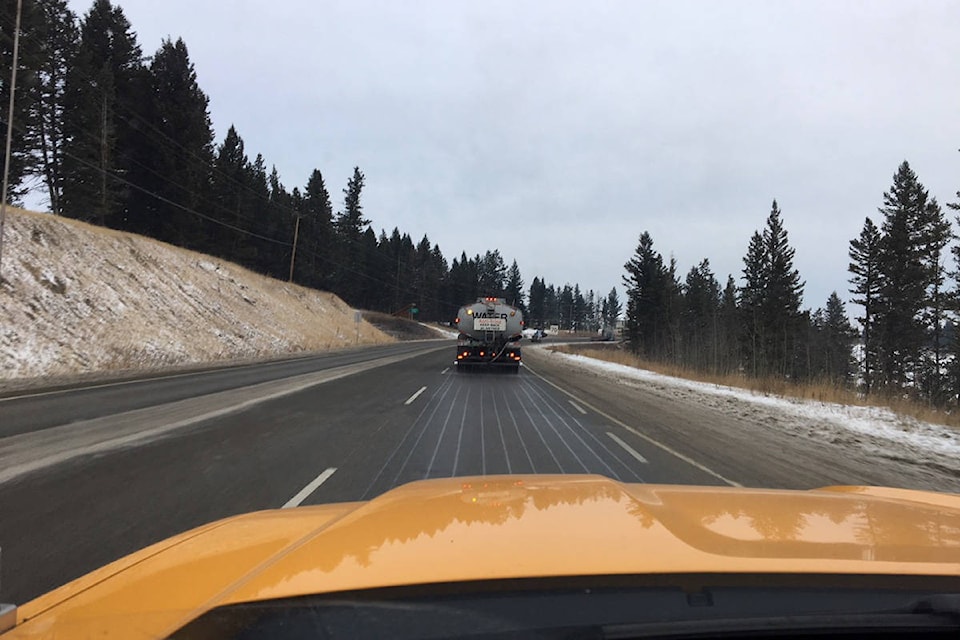Drivers on the major routes through 100 Mile House and surrounding areas have noticed a change in the ice melters applied to winter roads this year, according to reports on social media in the area.
Noting their cars are getting splattered with the wet muddy fluid, some indicated concern in a belief it was also more corrosive, but according to local management at Interior Roads Ltd. (IR), that’s not the case.
Daniel Hutchins, IR 100 Mile House Division operations manager, says the new process worked very well in the local area during a test run in the Cariboo last year. Now, it is being used in South Cariboo areas as a proactive measure to get a jump on slippery road conditions before they occur, he explains.
“It’s not more corrosive because it’s the exact same thing … the change is in how we are using it.”
What drivers are presumably noticing is the fluid sprayed on the roads, the same chemical now mixed with water to create a liquid.
“It is a sodium chloride – a salt-based brine. So instead of waiting for the storm, where we plow the roads off, get the compact [snow] off, then we put the solid salt on to melt it off.”
When traffic then begins to melt the snow off the pavement, these crystals of sodium chloride dissolve into a salt brine anyway, he explains.
“Once that salt brine is melted, it starts to work when it gets down to the pavement to create a break in between the compact and the pavement, and then we can scrape it off or the traffic works it off.”
Hutchins says IR is now premixing the same salt into a brine form so it can be sprayed on go to work as soon as the snow falls. This way, any existing snow melts enough to be removed by the IR plow before it can get packed down, he explains.
Hutchins notes IR has used this brine before, as just one of its tools, but never to this degree. Last winter, people may have noticed the same salt brine on the roads for about six weeks when IR performed the trial program in late December and early January, he adds.
“We trialled it last year and it had really good results in the 100 Mile area, so we’ve expanded it this year.
“We are continuing to expand it into our other areas as well – up into Williams Lake and down into Lillooet – but for now, 100 Mile, Bridge Lake Canim Lake – those are the ones we are focusing on.”
As always, there are temperature ranges and other conditions where it can be applied usefully, and then once it gets too cold, it’s too late, and the plows are back to scraping, he says.
“Unfortunately, we had all that snow in November and we used brine, but … then the temperature dropped to -20 [Celsius], and that’s just too late, it’s too cold for us to do anything.”
While salt solids work to about -5 or -6 C, Hutchins says this brine will work “a little colder than that,” and it is easier to time effective road clearing.
“We can see results because it’s already liquid. At those temperatures, it’s not as effective, and you don’t get traffic in heating the snow enough to form the brine for [that] to work, so the salt is usually just getting blown off into the shoulder.”
When IR can spray it – you can often see the little lines on the road – the brine prevents the compact snow from actually bonding to the pavement, he adds.
“Even if it doesn’t get to liquid form it prevents it from sticking to the road, when our plows come down it can scrape it right down to the pavement because it’s not stuck like glue.”
Hutchins says it is more expensive a process for IR to use liquid brine than salts, so their hope is it will balance off with reduced time in labour and equipment costs to scrape away at hard-packed ice and snow.
“When we used to do Highway 97, we’d have to have eight or ten trucks do passes in one day.
“Once we get it back to bare faster – now we can focus instead on the side roads, and put all of our efforts there.”
The area operations manager says the challenge has been the unusual weather patterns IR has been faced with so far this season. When IR can’t grade and salt brine the snow down to bare, everyone deals with compact snow for a few days, he explains.
“That’s the goal and it’s working out pretty well. Unfortunately, it’s been a strange year, and it’s been pretty much ‘feast or famine’ here. We are either sitting around waiting for the snow, or the snow is just overloading us.”
